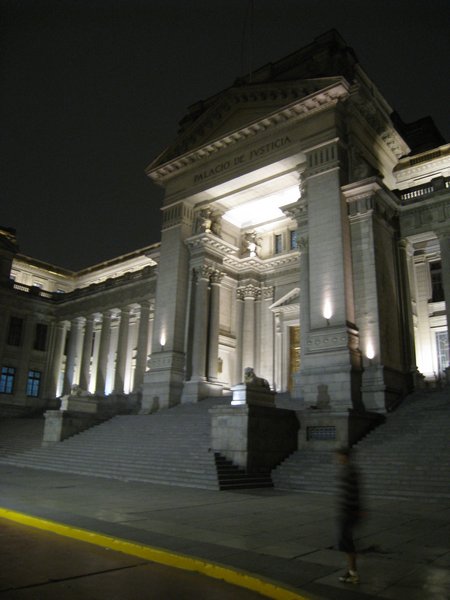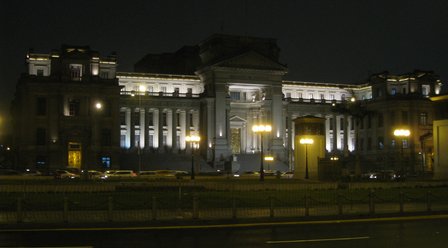(Click here for background on the Supreme Court Project)
Supreme Court of Peru, Palacio de Justicia, Lima, Peru
Address: Miguel Aljovin, Lima, Peru, by Estacion Central subway (Map)
Unlike our Ecuadorian adventure, our visit to the Supreme Court of Peru didn't feature any impromptu meetings with publicity officers. Our cab driver didn't know the way to the Supreme Court--and wondered why two foreigners wanted to go there--but he did know the Sheraton Lima, which faces right across the park from the fantastic Palacio de Justicia, and we could guide him from there.
Thus, we emerged into a sunny afternoon in front of a grand neoclassical structure that takes up most of a city block and houses the upper levels of the Peruvian judiciary. According to Wikipedia, the Peruvians modeled the building off of the law courts of Brussels, and the building does have a very heavy, European feel. Foolishly, I tried to walk up the steps to the front entrance, only to be rebuffed by a uniformed clerk who insisted that if we wanted to enter, we needed to go in the side door.

The Palacio de Justicia, at night
There are no signs advising where to go as a "visitor," although there is a public entrance on the north side of the building. Unlike the grand facade, these doors are more pedestrian steel affairs, and a small crowd of litigants, attorneys and document carriers milled around waiting for admission to begin at two o'clock. We were in no hurry, and so wandered in a complete circuit around the building. To the northwest, a dirty park sat forlornly across the street from a few cantinas. Surrounding the Palacio on the west and south are the offices of government and private attorneys, both of whom were privileged to use entrances limited only to officialdom. The private offices to the south are a particularly interesting mix. Some bore clean, polished bronze plaques announcing the name of the lawyers within, while the windows of other offices were festooned with dot-matrix banners annoucing "ABOGADO" in faded grey letters.
The public doors still hadn't opened when we made it back to the public entrance, so we made our way northeast up Azangaro street. Here the shops are most definitely lawyer-focused: I have not seen so many places to buy highlighters, binders, binder clips, printing services or other paper-based products in my life. Mixed amidst these are a number of cheap coffee and sandwich shops, where it would be hard to pay more than five dollars for lunch.
Feeling well fed on ham sandwiches, we returned to find that the public doors had opened in our absence. The crowd was now slightly larger, but also slowly making its way past security. A few attorneys (or perhaps employees of attorneys), sweating in the sun outside the door in navy blue wool suits, approached us to ask if we needed counsel. They were skeptical that the guards would let us in as tourists, but we actually didn't have much trouble. This may be because the guard asked if we were attorneys, we said "yes," and he let us by without inquiring further as to our business.
Most institutions place grand public facades over less impressive interiors where work actually gets done. For instance, Capitol Hill looks picture postcard perfect from the Mall, and once inside everything is grand views and stern paintings of founding fathers. Few visitors ever guess that underneath squirms a maze of twisty concrete passageways, painted in dull institutional colors, that snake their way to various congressional office buildings. So it is with the Palacio de Justicia: as imposing as the facade looks from out front, the public entrance leads into a near-windowless basement, the entrance hall lined by clerks windows and what appeared to be shops, a bank, and several enterprising stalls selling instructional videos. I think these last were either BarBri-style examination study guides or CLE videos.
No one stopped us from heading further into the warren of offices, where every hallway held a new collections of Secretariats, Clerk's Offices and other administrative necessities. The rooms with glass windows usually revealed some small desk, perhaps with a computer but often with a typewriter, surrounded by enormous jenga-balanced stacks of paper. While U.S. courts and law offices are far from paperless, the sheer volume of paper, often taking up most of the interior space of a room, brought home just how much has changed in my lifetime with the near-ubiquity of online documents.
Another unexpected feature sits in the basement of the Palacio: a small chapel where those coming before the courts can pray. An older woman was, I think, making her way through a rosary, but otherwise it appeared empty.
The upstairs/downstairs nature of the Palacio becomes immediately apparent when you happen across any of the marble staircases leading upwards from the bottom level. Most of the basement is flourescent, contrasting sharply with the natural light that filters its way down the stairwell by reflecting off the white stone. Once up the stairs, ceilings are much higher, hallways form around broad courtyards, and institutional paint on concrete is replaced with marble, brass and stained wood doors.
I wish that we could have taken pictures inside the courthouse, as the Palacio is one of the most beautiful of those we visited. Sunlight that pours through stained glass windows depicting Justice and what were either saints or figures from Peruvian history, bathing the airy interior in light. Tall white columns with Corinthian capitals support the roof. Along the wide, well-decorated hallways in front of the judges' administrative offices sit display cases with antique firearms, aged leather books and other Peruvian historical paraphenalia. (I have only been able to find one picture of the interior online, this shot from a Peruvian singer.)
Towards the front of the building lie the courtrooms of the Supreme Court. Divided into three sectors--Constitutional and Social, Civil, and Criminal--each sector has its own set of rooms. The Constitutional sector did not seem to be in session on the day that we visited, but several of the Civil sector courtrooms were hosting hearings. I listened in on one from the doorway, and it seemed a relatively sedate affair. The courtroom held few visitors, although one side of the courtroom was occupied with a series of desks, each containing a black-suited young man, presumably a clerk for the court. An elderly lawyer, grey hair fading to bald, read his presentation from a document that he held in front of him. The justices let the attorney speak for about two minutes, while one member of the panel stared fixedly at the computer screen on his bench. Finally, one of the judges asked a question, politely and in a low voice, whereupon the attorney answered and continued his speech.
Unclear on whether non-litigants were allowed, we didn't go into a hearing itself, but instead made our way in a circuit around the various courtrooms, trying to make sense of the dockets posted on the walls. I admired the decorations: wall clocks set into the marble, and heavily-ornamented brass lamps rising from the railings on the second floor. We passed very few people, especially in comparison to the busy basement, and if anyone wondered what we were doing there, he didn't ask.
A few minutes later, we walked out the doors we'd come in, crossed the park, and had a look in the Sheraton Lima. At least viewed from the lobby, it's a fine hotel, and certainly convenient if you ever have business before the courthouse. Walk one hundred feet north of the Sheraton and you can buy a variety blended of pisco sours in the middle of an upscale shopping mall, assuming that all of the legal tourism has left you with the need for a drink.
We did manage to get some exterior pictures of the Palacio on our way to the airport as we left for Argentina. The building looks incredible at night.


Leave a comment